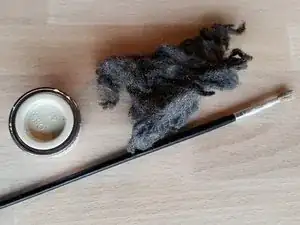
How to clean a rusting Microwave
These are some common tools used to work on this device. You might not need every tool for every procedure.

A microwave can hold an electrical charge of thousands of volts in its capacitors for hours or even days after it has been unplugged, and can result in electrocution or death if proper precautions are not used.
A microwave oven, often colloquially shortened to microwave, is a kitchen appliance that heats food by bombarding it with electromagnetic radiation in the microwave spectrum causing polarized molecules in the food to rotate and build up thermal energy in a process known as dielectric heating.
Microwave ovens heat foods quickly and efficiently because excitation is fairly uniform in the outer 25–38 mm of a dense (high water content) food item; food is more evenly heated throughout (except in thick, dense objects) than generally occurs in other cooking techniques.
This type of study aims to enable future repairers to repair autonomously a category of appliance using an example in the form of photos, diagrams, explanations, and repair guides.
In this page, we explain what the device is made of, show the different components, the roles they play, how they work individually, and how they work together.
We do not only show the disassembly or reassembly of the devices, since we aim to study a category of objects. Within the same category, no two devices are alike, either from one brand to another or within the same brand. So it's impossible to say which tool to use and how to go about it. If you're having trouble, you'll have to search iFixit and the Internet for the right tool for the right model.
We aim to show that you can learn by doing. The advantage is that you can progress "smartly" by understanding "how it works". Once you've got the hang of it, you can do it again and again, and on other machines.
Nor is it a question of redoing what has already been done. We select the quality content that already exists, add to it if necessary, and aggregate it around a "methodological" axis designed to provide solutions in an autonomous and secure repair approach.
Carrying out a repair is like conducting an investigation. You have to gather evidence, ask questions, observe, find clues, analyze evidence, and verify alibis. Then it's on to identifying and catching the suspect :-)
This investigation must be carried out methodically.
This is the method we'd like you to discover. To start repairing any appliance, from the simplest to the most sophisticated, before even dismantling anything, we suggest you ask yourself 3 questions. This is the information-gathering phase.
This first phase is just as important as the repair itself because if the analysis has been carried out correctly, the repair will be that much easier.
The 3 questions to ask systematically are, in order:
What are the device's functions?
In the case of simple objects, it may seem pointless to ask this question, but for more complex ones, it's important to understand the origin of the failure. In this way, you can avoid going down the wrong path as much as possible.
What are the user instructions?
This is the logical follow-up to the first question. When you've grasped all the functions of the device, you need to understand how to use it. To do this, you can refer to the user manual, if available.
What's the problem?
The last question to ask is what's wrong with the device?
We need to determine whether the device is totally or partially out of order (hence the importance of the first question), what the symptoms are, whether an event has led to the failure, and anything else that can help us pinpoint the origin of the problem.
During this phase, it is necessary to test the object, observe what happens (*1) and confirm the nature of the problem(s), checking what works and what doesn't, to avoid any misunderstandings in further operations.
Once this initial information has been gathered, it's likely that an initial diagnosis can be established, enabling the next phase, the repair itself, to be carried out.
This phase consists of:
At the end of this phase, it's time to test the unit to make sure it's working properly.
In the workshop, this should be done with the user, and the success (or otherwise) of the operation confirmed.
(*1) Repairing is an exercise in observation that calls on (almost) all our senses.
For a successful repair, it's best to be in a quiet place, with plenty of space and good lighting.
(*2) IMPORTANT The dismantling of equipment, especially the latest models, is often a long and delicate operation, so make sure you have the necessary time and tools. Be aware that this may damage the appearance of the device, or even render it unusable in the worst case. It's a good idea to search iFixit and the Internet for dismantling tips, based on the model and make of the appliance.
If you're taking a live measurement, make sure you prepare for the measurement when the power is off, by plugging in the multimeter with grip-wires, for example. This allows you to carry out the check without having to handle potentially dangerous instruments.